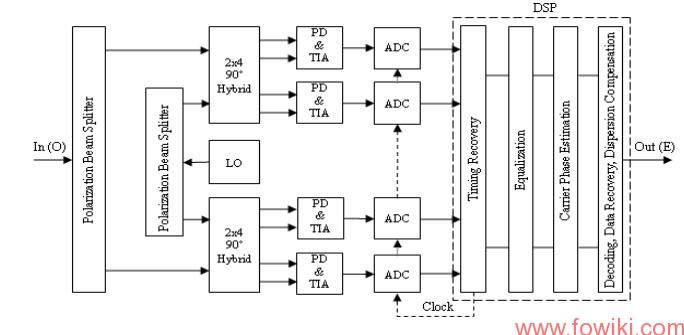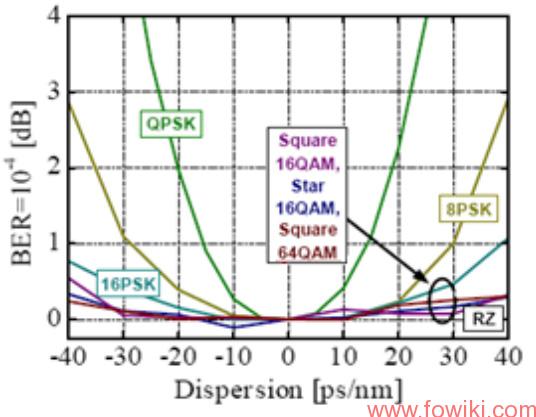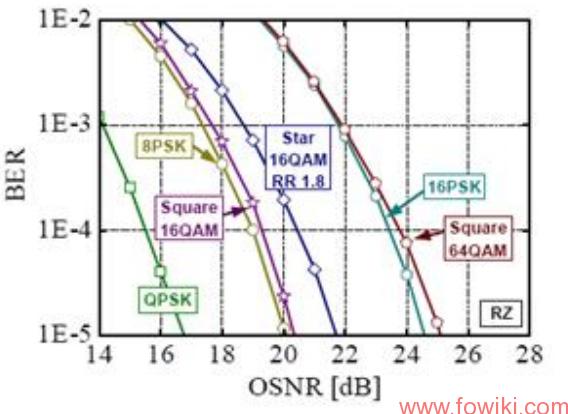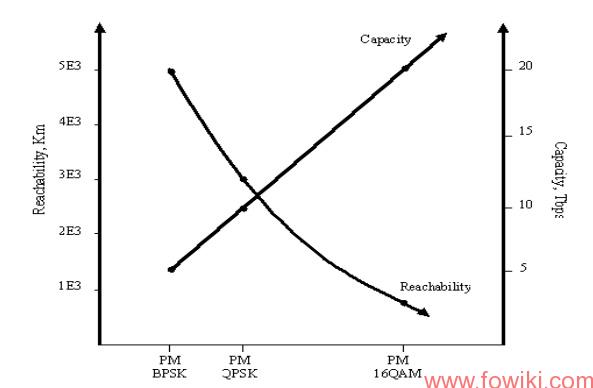1. Introduction
Since the late 1990, the transport capacities of ultra-long haul and long haul optical fiber communication systems has been significantly increased by the introduction of EDFA (Erbium Dropped Fiber Amplifier), DWDM, DCM (Dispersion Compensation Module), and FEC (Forward Error Correction) technologies. By utilizing these technologies, the universal on/off-keying (OOK) modulation along with direct detection receiver technology has been sufficient to address data rate up to 10Gbps per wavelength. An effort to improve spectral efficiency and robustness against transmission impairments, such as chromatic dispersion (CD) and polarization mode dispersion (PMD), researchers have investigated a variety of binary and non-binary modulation schemes, in conjunction with various detection techniques [1-3,13-17]. Optical coherent communications is such a novel approach which enables the modulation of data independently onto the I and Q quadratures of each of the two polarizations of an electromagnetic carrier wave. Resulting data rate increased four times than traditional IMDD transmission, and the line rate has been improved upto 100Gbps for long haul communication. However, due to the high carrier frequency (around 100 THz) of light and lower losses in optical fiber, researcher have been investigating new approaches to improve optical line rate while ensuring a good trade-off between the spectral efficiency, power efficiency, optical reachability, and complexity/cost of the system.
The rest of the paper is organised as follows: Section-2 presents the non-coherent transmission techniques, where the most used IMDD technology is mainly discussed. Section-3 covers the coherent technique with advance modulation formats, where the line rate increment from 10Gbps to 100Gbps using coherent technology is discussed. Section-3 also discussed system tolerance with respect to different criteria as well as the factor of limitations. Gridless/flexible grid based super channel in which many carriers are used same channel in order to boost up the line rate toward Tbps is discussed in Section-4. Finally, section-5 contains the concluding part.
2. Non-coherent Transmission
When DWDM was first introduced the typical line rate was 2.5Gbps, and transmission technique was non-coherent where information is encoded onto the amplitude of the carrier and the receiver recovers the information by detecting the envelope of the received signal [10]. Such types of non-coherent systems are known as intensity modulated direct-detection (IMDD) systems. In this process an electrical signal which contains the information directly drives a light source such as a laser diode, where the intensity of the light generated, which is nonnegative at all times, is proportional to the input electrical signal. At the receiver, a photodetector is used whose output (an electrical signal) proportional to the optical power incident upon it. Here, the modulated signal encodes a single bit (a 1 or 0) in each symbol, and each symbol representing one cycle of a clock. This modulation technique is also known as on/off keying (OOK) modulation. It is simple to implement and uses very few optical components, but no more efficient in spectrum utilization. However, to increase line rate from 2.5Gbps to 10Gbps, the same modulation system had been served well by improving its modulation technique along with better dispersion management against fiber impairments [6,8]. Although IMDD is cost effective and simple to implement, there are two major drawbacks. Firstly, half of the transmitted power is in the carrier does not contain data information but results in 3 dB loss in signal to noise ratio (SNR). Secondly, an IMDD receiver is nonlinear because of the square-law detection, which makes it very inefficient to compensate the linear impairments of physical optical fiber such as chromatic dispersion (CD) and polarization mode dispersion (PMD) [3].
To increase wavelength spectral efficiency many alternative modulation formats, such as multilevel pulse amplitude modulation (M-PAM), multilevel phase-shift keying (M-PSK) and multilevel quadrature amplitude modulation (M-QAM), have been tested [12-14]. If the information to be sent is modulated on an electrical subcarrier using any I/Q modulation format, M-PSK or M-QAM, it could be transmitted successfully over an IMDD channel on condition that this electrical signal is DC-biased to become nonnegative at all times. This gives the opportunity of designing modulation formats which could be more power efficient than OOK and M-PAM. However, using these higher order modulation formats line rate has been increased upto 40Gbps, but the optical reachability has dramatically reduced (detail insection III) that made it inadequate for long haul deployment.
3. Optical Coherent Technology
Around 1990, the commercial feasibility of a coherent system for optical signal transmission was first investigated as a means to improve a receiver’s sensitivity. In contrast to optical direct-detection receiver technology, an optical coherent detection scheme would detect not only an optical signal’s amplitude but phase and polarization as well. Having knowledge of the carrier and phase will improve the performance of the demodulator. Coherent detection is also known as coherent demodulation. A coherent transmission system International Journal of Future Generation Communication and Networking must include some major functions like, advanced modulation format (amplitude/phase),polarization multiplexing, coherent detection, and high-speed analog-to-digital converters (ADC) along with sophisticated digital signal processing (DSP) technique. A systematic block diagram of coherent receiver is shown in Figure 1.

In coherent receiver the polarization beam splitter divides the input optical signal into two signals, where one consists the X-polarized component and the other consists Y-polarized component of the signal. Each polarized component is then passed through a 90 degree optical hybrid circuit, which consists of a two-by-two optical coupler with a 90 degree phase delay function implemented on one arm of the coupler [11]. This circuit are used to extract the I and Q phase components of the signal as a result of the interference generated by the local oscillator (LO). Then the components are passed through the individual photodiode (PD) and trans-impedance amplifier (TIA) array. Finally, the baseband electrical signals are digitalized by high-speed ADC array and the resulting digital signals are passed through a powerful DSP system. DSP with its advance technology and powerful algorithm, perform timing recovery, adaptive linear and nonlinear equalization and data recovery. In coherent detection DSP can able to completely compensate the CD and PMD that would be added with the signals when it travels along the physical fiber. Hence, no additional dispersion compensation module (DCM) is needed and resulting better reachability.
Due the enormous benefit of coherent demodulation, it is possible to transmit data using polarization multiplexed quadrature phase shift keying (PM-QPSK, also known as Dual-pol QPSK or DP-QPSK) modulation scheme without compromising optical reach. This advance modulation format utilizes the spectrum four times more than the conventional IMDD system (OOK modulation). Currently, the telecom industries use 100Gbps line rate using PM-QPSK scheme for long haul and ultra long haul transmission. The further increase of bandwidth for long haul and ultra long haul transmission will most likely be the adoption of more powerful non-linear compensation techniques in the coherent detection, and significant increase in DSP processing power.
The migration from traditionally used modulation schemes to the higher-order schemes significantly increased higher spectral efficiencies and fiber capacities as well, but it strongly influence the system performance. Due to the reduced symbol rates higher -order modulation formats increased robustness against CD and PMD. Figure 2 shows that as the modulation International Journal of Future Generation Communication and networking order increased in higher level the better dispersion compensation is occurred. On the other hand, we know that the multi-span long haul optical fiber transmission systems are typically limited by noise and Kerr nonlinearities. These noise performances degrade with increasing number of bits per symbol, which badly affected on optical reachability. As a result the optical transmission distance reduces as the modulation orders become higher. Figure 3 illustrates the BER performance of different higher-order modulation schemes with respect to receive optical signal-to-noise ratio (OSNR) at receiver unit. From Figure 3 it is also shown that as the modulation order is increase the noise performance become degrades.


Higher order modulation schemes will certainly be a useful mechanism to optimal utilization of total spectral efficiency for certain routes. It encode m = log2(M) data bits on M states per symbol, which leads to a reduction of the spectral width and allows upgrading to higher data rates with lower-speed components. But these additional bits required more power to transmit. Figure 4 illustrates the transmission power needed for various modulation formats. To understand Figure 4, it is assumed that the area of the small circles within the big circle represents the maximum optical power carried by this symbol. Hence, the optical power need to transmit each symbol modulated by higher order modulation scheme is much more compare to lower order modulated symbol. However, if the power exceeds the non-linear threshold for this fiber path, then optical penalty would be raised rapidly. Hence, to design an optical network it is essential to make trade-off between the capacity and reachability. Figure 5 demonstrates the relationship between capacity and reachability of higher-order modulation schemes.


4. Coherence Super Channel
It is clear that the emergence of the coherent receiver technologies allowed a dramatic improvement transmission rate towards 100Gbps per wavelength, with better spectral efficiency, and equivalent (or sometimes better) optical reach compared to 10Gbps IMDD systems. But, the movement toward Tbps per wavelength may not be possible in current decades due to two main reasons as: the minimum speed of electronic devices require for 1Tbps line rate using PM-QPSK is 320-Gbaud which may not be available at mentioned time period, and the system also require 11nm silicon chip to implement which also would be unavailable at above time span. However, the increased spectral efficiency and receiver specificity offered by high order modulation and coherent detection bring an opportunity to implement the coherent super-channels in which several optical carriers are combined to create a composite line side signal of the desired capacity, and which is provisioned in one operational cycle [6, 16, 18]. The analogy of super channel is illustrated in Figure 6.

Using PM-QPSK modulation and coherent detection to transmit 1Tbps line rate in long haul transmission coherent super-channel uses ten lasers those are run with 32-Gbaud electronics, compared to single laser 320-Gbaud electronics, and the system might be possible to implement in a single photonic integrated circuits (PIC) board. This technology is implemented based on ITU-T G.694.1 flexible-grid/gridless rather than fixed grid spacing. The spectral width for a 1Tbps gridless super-channel varies from about 200GHz (PM-16QAM)to about 750GHz (PM-BPSK). But all of these super-channels can be accommodated efficiently using a multiple of 12.5GHz.
5. Conclusions
Today’s DWDM has become an efficient transmission system with the combination of advanced modulation formats and coherent receiver technology. Together these technologies have allowed the DWDM transmission system to transform from 10Gbps to 100Gbps per wavelength. The result is a tremendous increase in spectral efficiency, while comparatively superior optical reach and cost. Further improvement of spectral efficiency might be involve the use of higher order modulation schemes, ultra-speed ADC, more powerful DSP and sophisticated FEC technology. But, according to current available electronic devices (Specially, ADC), data rate above 100Gbps per wavelength is not possible for long haul communication. However, Moore’s law suggests a more powerful DSP system which may able, together with effective algorithm, to permit higher-order modulation for long haul transmission.
However, DWDM super-channels potentially offer an ideal solution to the twin problems of increasing optical transport capacity beyond 100Gbps and providing the flexibility to maximize the combination of optical capacity and reach. By implementing a super-channel with many optical carriers, we can reduce the requirement for exotic electronics, allowing this technology to be delivered much more quickly than other options. The key to a multi-carrier super-channel is the use of large scale PICs to reduce optical-circuit complexity and offer the maximum flexibility for an engineering design.
About Author:
Md. Shipon Ali achieved his B.Sc. in Electronics & Communication Engineering degree from Khulna University, Bangladesh in 2009. Now, he is working as a ‘senior Engineer’ in a telecom service provider in Bangladesh. His research interests are optical communication system, 4G mobile communications and digital signal processing system. He also achieved ‘University Gold Medal’ from Khulna University for securing first position with distinction by obtaining the highest CGPA in Bachelor Examinations among all disciplines under School of Science, Engineering and Technology in the session 2007-2008.